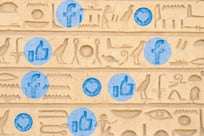The science of genetics has particular importance for Arab populations, among whom inherited conditions are relatively common.
Historically, one major reason for this has been the prevalence of marriages between cousins. Less well-known is the fact that some genetic conditions were once beneficial for those living in this part of the world - notably the blood disorder sickle cell anaemia, which confers protection against malaria.
Once upon a time, those attending meetings like this four-day event would tell anyone who would listen that victory against such lethal conditions was now in sight. Such optimism flowed from one of the most trumpeted scientific breakthroughs of the past half-century: the unveiling in 2000 of the first rough draft of the human genome.
The genome is often described as the "genetic book of human life". Decoding it was predicted to lead to a host of advances, from "personalised" medical treatment to the discovery of genetic risk factors for diseases like cancer - and cures for some genetic diseases.
A decade on, however, the mood of geneticists is far more downbeat, although the quest remains as inspiring as ever. There's no doubt that medicine would be transformed if doctors could tailor drugs and dosage to each individual.
For example, many hundreds of people die each year in the UAE because of adverse drug reactions.
The assumption has been that the root cause of such reactions lies in each person's genes, and the dream has been that one day doctors would simply check a patient's genome and reach for precisely the right drug, confident there would be no side effects.
Yet with very few exceptions, the dream seems more like a mirage. To date, only a small minority of women with invasive breast cancer have benefited from anything close to personalised medicine.
These women carry an overactive gene called Her2/neu, and research has shown that about half of them can benefit from a drug called Herceptin. But this drug has itself been found to increase the risk of heart dysfunction, for reasons unknown.
Genetic researchers have fared little better trying to link genes to common ailments such as heart disease and cancer.
Grand "genome-wide association" (GWA) projects have been set up, with the aim of trawling the genomes of thousands of people. But in return, researchers have been rewarded with a baffling melee of faint trails and dead ends.
The GWA technique first made headlines in 2007, when several different teams unveiled the existence of 12 genetic quirks apparently linked to coronary artery disease, the clogging up of arteries.
The disease has long been linked to factors such as high cholesterol. Yet only a handful of the genetic quirks were linked to these factors; the role of all the others remains a total mystery.
More baffling still, the 12 are all but useless at predicting who will suffer the condition - suggesting that even when their role is tracked down, the information will be of little help.
Just last week the journal Nature Genetics reported the discovery by three independent teams of 18 more genetic quirks linked to coronary artery disease. Even when combined with those previously known, however, experts estimate these genes will explain only about 10 per cent of the risk.
Nowhere is the schism between genome hype and reality starker than in the treatment of inherited diseases.
The quest for a cure began long before the human genome project, with scientists focusing on the simplest disorders, caused by faults in single genes. In 1989, a team at the Hospital for Sick Children in Toronto identified the gene for cystic fibrosis, one of the most common of all genetic diseases.
For years afterwards, geneticists talked of curing this fatal disease simply by replacing the faulty gene, like car mechanics fixing an engine by replacing the spark plugs.
Yet to this day, not a single patient has been cured of cystic fibrosis, or indeed any other common genetic disorder. Their life expectancy has certainly improved - in the case of cystic fibrosis patients, by 10 years or more - but credit for that goes to conventional medicine, not genomic research.
The common thread in this litany of disappointment is the simplistic idea of genes being "for" specific traits.
Researchers who should have known better - including a few Nobel Prize winners - cheerfully foisted this view of genes on the public, the media and worst of all, themselves. Ironically, the best evidence against it has come from the genome project itself.
One of the first discoveries from the project was the amazingly low number of genes in the human genome. Before the project began, most geneticists expected to find at least 100,000 genes.
We now know the true figure is about 23,000 - far fewer than for many parasites. The implications are clear: there is no simple relationship between genes and the living organism they supposedly define. Genes aren't at all like the "words" in a "genetic book of human life".
Metaphor plays a key role in science, defining how entire generations of researchers view their subjects. Physicists once thought of gravity as being some kind of invisible "elastic" between masses, light as made of waves, and electrons as subatomic bullets.
All these metaphors have their uses, but they also have their limits - and the success of physicists owes much to their ability to choose the right metaphor for the job.
For decades, geneticists have tried to emulate the success of physicists, and have taken a reductionist, mechanistic view of genes. Their lack of progress in understanding the genome suggests they should spend some time at this week's meeting finding a better metaphor for genes. Lives depend on it.
Robert Matthews is Visiting Reader in Science at Aston University, Birmingham, England.





